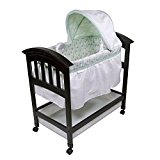Bassinets are convenient and cozy for newborns, but be sure to pay attention to the height and weight requirements of various models. Since they are a lot more shallow than a crib, it may no longer be safe once your baby starts rolling around or pulling up.
The most obvious safety requirement when using co sleepers or bassinets is to follow the weight and height requirements, and other manufacturer guidelines. Additionally, here are some other guidelines to follow when you’re looking for the safest bassinet for your newborn.
The bassinet should have a firm, flat mattress with only a fitted sheet.
Soft mattresses increase the risk of suffocation, as do loose blankets. Keep loose bedding and soft objects out of the bassinet. Even loose blankets are not advised since once your baby starts to move they could get twisted or end up with their face covered.
Place your baby to sleep on their back.
Once your baby is able to roll from their back to their stomach by themselves, they can remain in the sleeping position that they choose, but until then they should be placed to sleep on their backs.
Swaddling should be discontinues at 8 weeks of age, or when your baby can roll over.
The AAP (American Academy of Pediatrics) recommends discontinuing swaddling before infants can roll over onto their stomachs due to infant deaths from suffocating on their stomachs while swaddled.
Use mesh walled bassinets or breathable bumpers.
The risk of suffocation is also reduced if the sides of the bassinet are breathable. Most modern bassinets come with breathable sides as a safety precaution.
Ensure the stand is set properly or the wheels are locked.
If your bassinet has wheels, make sure you lock them after moving the bassinet to where you’re going to be using it.
Bedside Co-sleepers
A bedside co-sleeper is a bassinet that is designed to be pulled up to the side of the bed, rather than lie in the bed with you. They sometimes attach to the side of the bed. Bedside co-sleepers allow you to make it like you are bed-sharing, but still give your baby their own space.
Some mothers choose to sleep in the same bed as their newborn, either to make night feedings easier or for attachment and bonding reasons.
Having your newborn baby close by at night will make things easier, and bedside co-sleepers are a safer alternative to bed-sharing.
| Arms Reach Concepts Mini Ezee 2-in-1 Co-Sleeper
A safer alternative to bed sharing that is small and attaches to the side of your bed. |
|||||||||
|
|||||||||
| Read our full Arms Reach Concepts Mini Ezee 2-in-1 Co-Sleeper Review | |||||||||
 |
Summer Infant Classic Comfort Wood Bassinet
This bassinet on wheels plays soothing melodies, calming sounds, and vibrates to help lull your baby to sleep. |
||||||||
|
|||||||||
| Read our full Summer Infant Classic Comfort Wood Bassinet Review | |||||||||